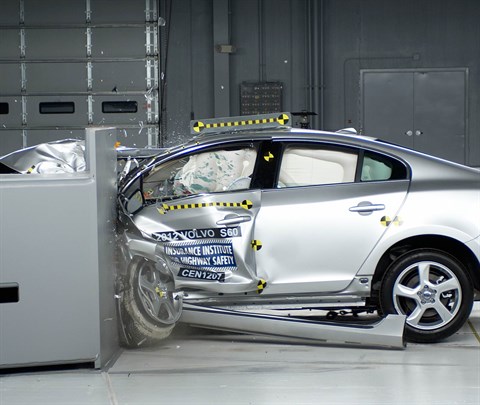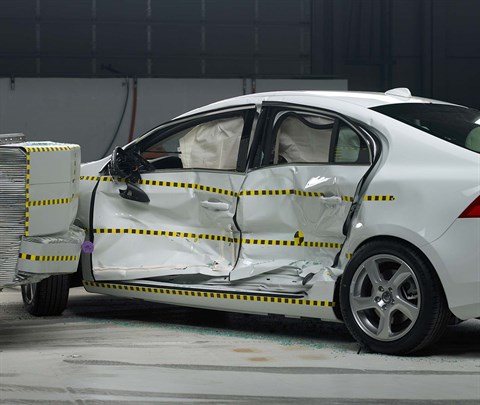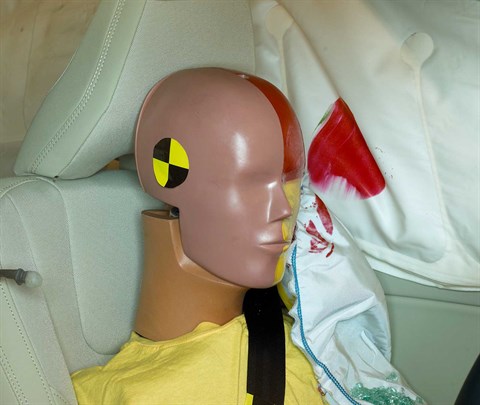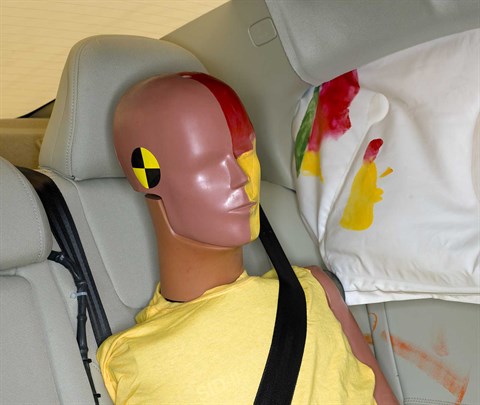Small overlap front: driver-side
Rating applies to 2011-18 models
Tested vehicle: 2012 Volvo S60 T5 4-door
The Volvo S60 was redesigned for the 2011 model year. The small overlap frontal crash test ratings also apply to the station wagon version of the S60, known as the Volvo V60, introduced in the 2015 model year.
| Evaluation criteria | Rating |
|---|---|
| Structure and safety cage | |
| Driver injury measures | |
| Head/neck | |
| Chest | |
| Hip/thigh | |
| Lower leg/foot | |
| Driver restraints and dummy kinematics The dummy’s head contacted the frontal airbag but slid left into a gap in coverage between the frontal and side curtain airbags, leaving the head vulnerable to contact with forward side structure and outside objects, despite good stability of the steering column. This gap is mainly due to a combination of the narrow, asymmetric frontal airbag and a curtain airbag that doesn't extend sufficiently forward. The side torso airbag deployed. | |

Action shot taken during the small overlap frontal crash test.

The dummy's position in relation to the door frame, steering wheel, and instrument panel after the crash test indicates that the driver's survival space was maintained very well.

During the crash, the dummy's head slipped into the gap between the narrow frontal airbag and the side curtain airbag, which does not extend far enough forward.

Intrusion into the driver's space was minimal, and risk of injuries to the dummy's legs and feet was low.
Moderate overlap front: original test
Rating applies to 2011-18 models
Tested vehicle: 2011 Volvo S60 4-door
The Volvo S60 was redesigned for the 2011 model year. Moderate overlap ratings are assigned by the Institute based on a test conducted by Volvo.
The moderate overlap frontal crash test ratings also apply to the station wagon version of the S60, known as the Volvo V60, introduced in the 2015 model year.
| Evaluation criteria | Rating |
|---|---|
| Overall evaluation | |
| Structure and safety cage | |
| Driver injury measures | |
| Head/neck | |
| Chest | |
| Leg/foot, left | |
| Leg/foot, right | |
| Driver restraints and dummy kinematics | |
Side: original test
Rating applies to 2011-18 models
Tested vehicle: 2012 Volvo S60 T5 4-door with standard front and rear head curtain airbags and standard front seat-mounted torso airbags
The Volvo S60 was redesigned for the 2011 model year. The side crash test ratings also apply to the station wagon version of the S60, known as the Volvo V60, introduced in the 2015 model year.
| Evaluation criteria | Rating |
|---|---|
| Overall evaluation | |
| Structure and safety cage | |
| Driver injury measures | |
| Head/neck | |
| Torso | |
| Pelvis/leg | |
| Driver head protection | |
| Rear passenger injury measures | |
| Head/neck | |
| Torso | |
| Pelvis/leg | |
| Rear passenger head protection | |

View of the vehicle and barrier just after the crash test.

View of the vehicle after the crash with doors removed, showing the side airbags and damage to the occupant compartment.

Smeared greasepaint shows where the driver dummy's head was protected from being hit by hard structures by the side airbags.

Smeared greasepaint shows where the rear passenger dummy’s head was protected by the side airbag.
Roof strength
Rating applies to 2011-18 models
Tested vehicle: 2012 Volvo S60 T5 4-door
Rating applies to both the Volvo S60 4-door sedan (tested) and the structurally similar Volvo V60 station wagon.
| Overall evaluation | |
|---|---|
| Curb weight | 3,563 lbs |
| Peak force | 17,650 lbs |
| Strength-to-weight ratio | 4.95 |
Head restraints & seats
Seat type: All Seats
| Overall evaluation | |
|---|---|
| Dynamic rating | |
| Seat/head restraint geometry |
About the head restraint & seat test
Currently, IIHS tests apply only to front seats.
Front crash prevention: vehicle-to-vehicle
Ratings are given for 2 different trim variations available on this vehicle.
